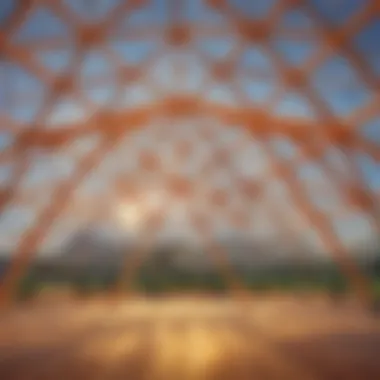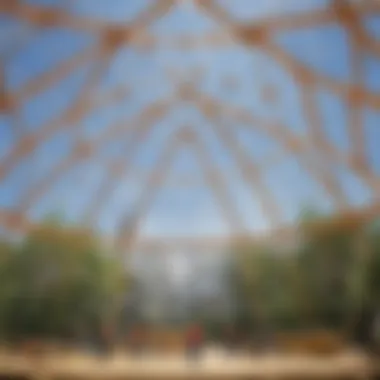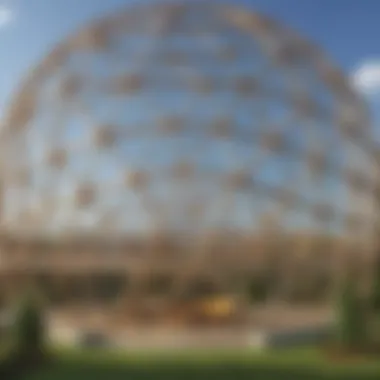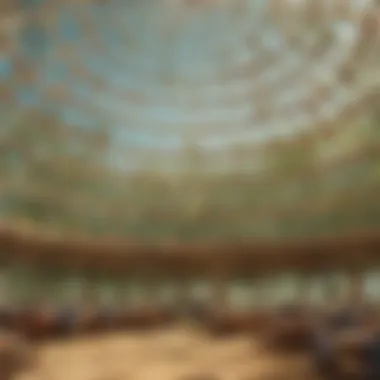Unraveling the Fascinating Geodesic Dome Structures: A Journey of Beauty and Functionality


Science Fun Facts
Geodesic domes are spherical or partial-spherical structures made up of interconnected triangles, providing exceptional structural strength and efficiency. These unique geometric shapes are inspired by natural forms, such as soap bubbles and honeycombs. The concept of geodesic domes was popularized by architect and inventor, R. Buckminster Fuller, who believed in creating sustainable and cost-effective shelters.
Discover the Wonders of Science
In exploring the wonders of geodesic dome structures, one delves into the fascinating intersection of art and engineering. They exemplify innovative design principles through their use of minimal materials while maximizing interior space. Geodesic domes harbor diverse applications ranging from housing structures, eco-friendly habitats, to futuristic architectural marvels.
Science Quiz Time
Interactive quizzes about geodesic domes can challenge your knowledge. Test your understanding of the structural integrity, history, and practical uses of geodesic domes through brain teasers and multiple-choice questions. Engage in gamification learning experiences that deepen your appreciation for these unique architectural wonders.
Science Experiment Showcase
Embrace hands-on learning with geodesic dome construction experiments. Follow step-by-step instructions to build mini geodesic domes using straws or popsicle sticks. Experiment with different sizes and materials, discovering the impact on stability and strength. Prioritize safety by wearing goggles and assembling in a well-ventilated area.
Introduction to Geodesic Dome Structures
In the vast landscape of architectural wonders, geodesic dome structures stand out as an innovative and exceptional creation. These domes, with their interconnected triangular elements forming a spherical or hemispherical shape, represent a unique blend of art and engineering. The importance of understanding geodesic dome structures lies in their unparalleled strength, efficiency in material usage, and aesthetic appeal. By unraveling the mysteries of geodesic geometry, we uncover not just a structural form but a concept that challenges traditional architectural norms.
Understanding Geodesic Geometry
The foundation of geodesic domes
Exploring the foundation of geodesic domes unveils the core principles that define their structural integrity. The strategic use of triangular elements distributes stress evenly throughout the structure, resulting in remarkable strength and stability. This foundational aspect not only enhances the dome's durability but also optimizes the utilization of building materials, making geodesic domes an efficient and sustainable choice for architectural design.
The mathematical principles behind geodesic structures
Delving into the mathematical foundations of geodesic structures reveals the precision and complexity involved in their construction. From the intricate calculations of triangular intersections to the utilization of geodesic grids, mathematics plays a pivotal role in achieving structural harmony within dome designs. By intertwining mathematical principles with architectural ingenuity, geodesic structures push the boundaries of conventional building methods, offering a glimpse into the synergy of science and art.
Buckminster Fuller: The Visionary Architect
The life and work of Buckminster Fuller
Buckminster Fuller's unparalleled contributions to architecture redefine the boundaries of innovation and sustainability. His life story reflects a relentless pursuit of visionary concepts that prioritize efficiency and functionality in design. Fuller's embrace of geodesic principles heralded a new era in architectural aesthetics, emphasizing simplicity, strength, and environmental consciousness. Through his life's work, Fuller left an indelible mark on the architectural landscape, inspiring generations to think beyond traditional norms.


Fuller's influence on geodesic dome design
Fuller's visionary approach to design revolutionized the realm of geodesic domes, introducing avant-garde concepts that challenged existing paradigms. His emphasis on lightweight materials, structural efficiency, and geometrical elegance reshaped architectural perceptions worldwide. The influence of Fuller's geometric innovations continues to resonate in contemporary dome designs, illustrating his enduring impact on architectural evolution.
Advantages of Geodesic Domes
Durable and resilient construction
The durability and resilience of geodesic domes stem from their unique structural properties. By dispersing external loads evenly across the entire framework, these domes exhibit exceptional strength, capable of withstanding diverse environmental conditions. Their inherent stability not only enhances longevity but also ensures minimal maintenance requirements, making them a cost-effective and reliable architectural solution.
Sustainable and eco-friendly features
Embracing sustainable practices, geodesic domes excel in eco-friendliness by maximizing energy efficiency and minimizing material waste. The efficient use of resources, coupled with their excellent ventilation and insulation properties, renders geodesic domes as environmentally conscious structures. By integrating green technologies and renewable energy sources, these domes epitomize sustainable architecture, paving the way for a greener and more harmonious built environment.
Construction and Design Aspects
In the realm of geodesic dome structures, the Construction and Design Aspects play a pivotal role, forming the foundation of these architectural marvels. The intricate process of constructing and designing geodesic domes involves a meticulous fusion of art and engineering expertise. From selecting the most suitable materials to implementing innovative assembly techniques, every aspect contributes to the structural integrity and aesthetic appeal of these domes. Through a detailed exploration of Construction and Design Aspects, this article aims to shed light on the essential components that shape geodesic dome creation.
Materials Used in Geodesic Domes
Steel, Aluminum, and Other Common Materials
The choice of materials in geodesic dome construction is a critical decision that influences the durability, strength, and sustainability of the final structure. Steel, aluminum, and other common materials stand out as popular options due to their exceptional structural properties and versatility. Steel, known for its unparalleled strength and resistance to corrosion, provides the necessary support for the overall dome structure. Aluminum, on the other hand, offers a lightweight yet robust alternative, ideal for achieving intricate geometries while ensuring longevity. These materials not only enhance the structural stability of geodesic domes but also contribute to their modern aesthetic appeal, reflecting a harmonious blend of strength and elegance.
The Role of Tension and Compression Elements
Within geodesic dome construction, tension and compression elements play a vital role in distributing loads and maintaining structural equilibrium. Tension elements, such as cables or rods, provide the necessary support by withstanding pulling forces and ensuring the dome's stability. In contrast, compression elements, such as struts or beams, bear the weight of the structure and resist compressive forces, reinforcing the overall framework. The strategic arrangement of these elements optimizes the dome's load-bearing capacity and structural resilience, allowing for efficient stress distribution and maximum structural efficiency. By discussing the significance of tension and compression elements, this section strives to illuminate the intricate interplay between structural components in geodesic dome design.
Assembly Techniques
The Process of Constructing a Geodesic Dome
The process of assembling a geodesic dome involves a series of intricate steps that culminate in the creation of a robust and visually appealing structure. From erecting the foundation to meticulously positioning each strut or panel, every phase demands precision and expertise. The seamless integration of various components requires meticulous planning and coordination to ensure the structural integrity and geometric accuracy of the dome. By elucidating the nuances of dome assembly, this article aims to unravel the complexities of the construction process, offering insights into the craft and dedication required to bring geodesic dome designs to life.
Challenges and Innovations in Dome Assembly
Despite the advancements in construction technologies, geodesic dome assembly presents unique challenges that test the limits of conventional building practices. Innovations such as modular construction techniques and robotic automation have revolutionized the assembly process, streamlining efficiency and accuracy. However, challenges related to achieving precise geometric alignments and ensuring airtight seals persist, necessitating continuous innovation and problem-solving. By delving into the realm of challenges and innovations in dome assembly, this section seeks to highlight the dynamic nature of geodesic dome construction and the ingenuity required to overcome obstacles.


Design Flexibility and Variations
Spherical and Hemispherical Dome Structures
The design flexibility of geodesic domes extends to the variety of shapes and forms that can be achieved, with spherical and hemispherical structures standing out as popular choices. Spherical domes offer a classic appeal, embodying a harmonious balance between curvature and stability. On the other hand, hemispherical domes provide a more compact and enclosed space, making them suitable for specific applications such as observatories or residential dwellings. The unique geometric properties of spherical and hemispherical designs not only enhance the visual intrigue of geodesic domes but also present opportunities for innovative structural configurations and aesthetic expressions.
Customization Options and Creative Designs
Beyond standard dome configurations, geodesic structures offer vast customization options that cater to diverse preferences and functional requirements. Creative designs, ranging from organic forms to futuristic interpretations, showcase the adaptability and versatility of geodesic dome architecture. The ability to customize panel patterns, apertures, and surface treatments enables architects and designers to imbue each dome with a distinctive character and purpose. By exploring the realm of customization options and creative designs, this section aims to underscore the boundless creativity and potential inherent in geodesic dome architecture.
Applications Across Various Sectors
Geodesic domes find versatile applications across various sectors, making them a topic of significant interest in this article. The inherent strength and efficient use of materials in geodesic dome construction have led to their popularity in diverse fields. From architecture to science and entertainment, geodesic domes offer innovative solutions and unique aesthetic appeal. Exploring the specific elements and benefits of geodesic domes in different sectors sheds light on their wide-ranging utility and potential for future growth.
Geodesic Domes in Architecture
Domestic Housing and Eco-Resort Designs
The incorporation of geodesic domes in domestic housing and eco-resort designs highlights their versatility and sustainability. These structures provide a blend of structural strength and energy efficiency, making them a compelling choice for eco-conscious individuals and developers. Their unique design promotes natural light penetration and efficient space utilization, enhancing the living experience while reducing environmental impact. Despite their unconventional appearance, geodesic domes offer a spacious and comfortable interior, adapting well to various environmental conditions.
Commercial Buildings and Public Structures
In the realm of commercial buildings and public structures, geodesic domes stand out for their striking visual appeal and cost-effective construction. The iconic spherical shape and efficient load-bearing capabilities make them an attractive option for large gatherings and events. Additionally, their quick assembly and durable nature make them ideal for temporary installations and semi-permanent structures. While offering a modern aesthetic, geodesic domes also excel in creating immersive environments for exhibitions, concerts, and other public gatherings.
Geodesic Domes in Science and Research
Planetariums and Observatories
Geodesic domes play a crucial role in housing planetariums and observatories due to their unobstructed views and acoustic properties. The spherical design minimizes visual obstructions, creating an ideal setting for stargazing and astronomical observations. Moreover, their structural stability and weather-resistant characteristics ensure reliable performance in various climatic conditions. Planetariums and observatories housed within geodesic domes offer an immersive experience for visitors while maintaining a harmonious connection with the surrounding environment.
Greenhouse and Agricultural Applications
Utilizing geodesic domes for greenhouse and agricultural applications showcases their potential for optimizing horticultural practices and crop production. The geodesic shape allows for efficient light distribution and temperature regulation, fostering optimal growth conditions for plants. Additionally, their scalability and customization options cater to different agricultural needs, enabling year-round cultivation in a controlled environment. Despite their initial investment cost, geodesic domes prove cost-effective in the long run by enhancing crop yields and resource efficiency.
Geodesic Domes in Entertainment and Events
Music Festivals and Outdoor Venues


Geodesic domes contribute significantly to the ambiance and functionality of music festivals and outdoor venues. The eye-catching design and spacious interior make them an ideal choice for hosting immersive multimedia experiences and live performances. Their quick setup and modular nature allow for flexible arrangements and expansive event spaces. While providing weather protection and acoustical benefits, geodesic domes enhance the overall attendee experience by creating a visually stunning environment.
Temporary Shelters and Exhibition Spaces
For temporary shelters and exhibition spaces, geodesic domes offer a blend of practicality and aesthetic appeal. Their portability and ease of assembly make them suitable for rapid deployment during emergencies or temporary events. The ample interior space accommodates various functionalities, from emergency housing to pop-up exhibitions. Despite their temporary nature, geodesic domes provide durability and structural integrity, ensuring a safe and versatile solution for short-term spatial requirements.
Future Prospects and Innovations
In the realm of geodesic dome structures, the horizon teems with potential innovations and advancements that could redefine architectural paradigms. As we peer into the future, exploring the trajectory of these marvels, the importance of envisioning new perspectives becomes paramount. Future prospects and innovations not only shape the built environment but also encompass sustainability, efficiency, and aesthetic appeal. By delving into emerging trends and visionary concepts, this article aims to unveil the next chapter in geodesic dome evolution.
Technological Advancements in Dome Construction
Integration of Digital Design Tools
The integration of digital design tools augurs a paradigm shift in dome construction methodologies, enabling architects and engineers to push boundaries and harness computational prowess. Paramount to this evolution is the seamless synergy between creativity and precision, facilitated by sophisticated software suites. These tools, ranging from parametric modeling to Building Information Modeling (BIM), streamline the design process, optimize material usage, and enhance structural integrity. The allure of digital design lies in its ability to transcend conventional constraints, fostering intricate geometries and multifaceted structural systems with unrivaled efficiency.
3D Printing and Robotic Construction Methods
The advent of 3D printing and robotic construction methods heralds a new era in geometric innovation, transcending traditional construction modalities. This cutting-edge technology empowers designers to actualize intricate geometries with unprecedented dexterity and speed. By layering materials in a precise, additive manner, 3D printing unlocks a realm of customization and complexity previously unattainable. Moreover, robotic construction techniques imbue domes with a sculptural quality, where robotic arms execute intricate maneuvers to assemble components with finesse and accuracy.
Sustainable Practices in Geodesic Architecture
In the pursuit of sustainable design, geodesic architecture stands at the vanguard of eco-conscious innovation, embodying the principles of environmental stewardship and resource efficiency. Central to this ethos is the integration of renewable energy sources, a cornerstone of sustainable architecture that minimizes environmental impact and promotes self-sufficiency. By leveraging solar panels, wind turbines, and passive heating techniques, geodesic domes exemplify a harmonious interplay between form and function, where energy efficiency converges with architectural elegance.
Renewable Energy Integration
Amidst the evolutionary landscape of geodesic design, renewable energy integration emerges as a pivotal facet of sustainable practice, underscored by its ecological benefits and long-term viability. Incorporating solar panels and wind harvesting mechanisms into dome structures not only reduces carbon footprint but also cultivates a symbiotic relationship with the natural environment. By harnessing renewable energy resources, geodesic domes transcend their architectural identity to become beacons of environmental responsibility and innovation.
Bioclimatic Design Strategies
Within the realm of geodesic architecture, bioclimatic design strategies emerge as a veritable modus operandi for harmonizing built environments with nature's rhythms. These strategies, rooted in sustainable principles, prioritize passive heating and cooling mechanisms, natural ventilation, and green roofing systems to optimize thermal comfort and minimize energy consumption. By embracing bioclimatic design, geodesic domes bridge the gap between ecological sensitivity and architectural ingenuity, exemplifying a holistic approach to environmental stewardship.
Exploring Novel Uses of Geodesic Domes
The unconventional vistas of geodesic domes extend beyond traditional architectural functions, encompassing groundbreaking applications that defy conventional norms and propel innovation to new horizons.
Emergency Housing Solutions
Amidst crises and contingencies, geodesic domes emerge as stalwart allies in providing durable and rapid housing solutions to communities in upheaval. With their robust structural integrity and efficient assembly processes, these domes offer shelter, safety, and dignity to those in dire need. The adaptability and portability of geodesic structures make them ideal candidates for emergency housing, illustrating the fusion of resilience and compassion in times of adversity.
Space Exploration Habitats
In the realm of space exploration, geodesic domes carve a niche as avant-garde habitats that encapsulate the essence of sustainability and innovation on extraterrestrial frontiers. Designed to withstand the rigors of space travel, these habitats embody a symbiosis of technological acumen and visionary design, fostering human habitation beyond Earth's confines. By harnessing the allure of geodesic geometry, space exploration habitats exemplify the marriage of ingenuity and resilience, charting new trajectories in interstellar architecture.







